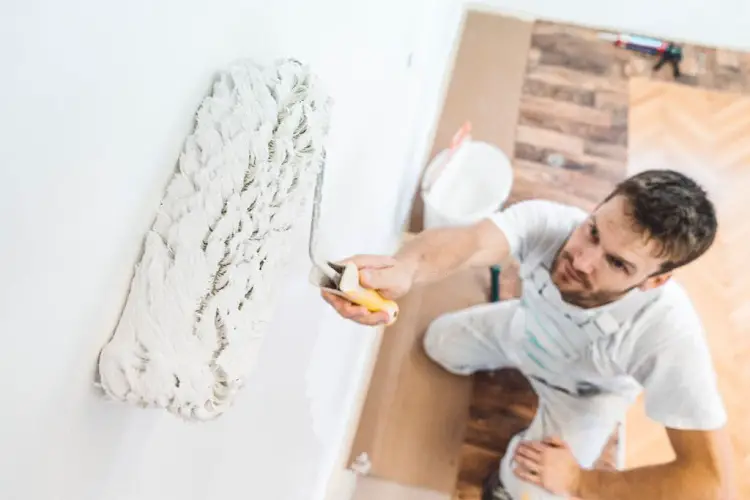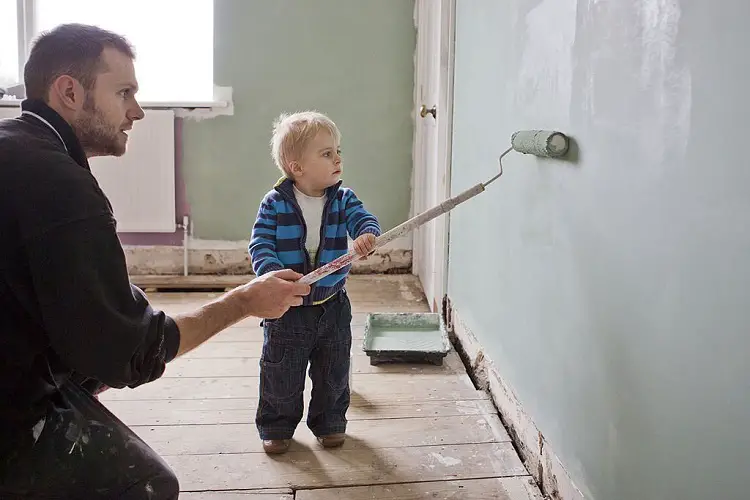In recent times a lot of people spend their time at home and while at home they try to be innovative.
Some people spend this time painting their rooms and that of their babies to fit into their idealized version.
So while you do this, you will have to be sure if your baby can sleep in a freshly painted room to avoid causing health complications for your baby.
This article will address the question of can babies sleep in a freshly painted room and other related questions.
Table of Contents
- Can Babies Sleep In A Freshly Painted Room?
- Why Wait Till Paint Is Dry?
- Things to Consider When Choosing Paints for Your Child’s Room
- How To Hasten The Time Before Your Baby Can Sleep In A Freshly Painted Room
- Practical Ways To Prevent Baby From Sleeping in a Freshly Painted Room
- Conclusion
Can Babies Sleep In A Freshly Painted Room?
This depends on the type of paint used. Generally, babies can safely sleep in a freshly painted room after 48-72 hrs (two to three days) after the paint has dried.
As you may know, some paints have a high drying rate and produce a low quantity of volatile organic compounds, while others may take a lot of time.
Technology advances and research are made daily to make life easier for people. There have been advances in the manufacturing processes of paints, and paints will need three to four hours to dry off.
If you have this paint, your baby can sleep in the same room for three to four hours. Before it is fully dried, it is still advisable that your baby isn’t allowed into the newly painted room until it is dry.
Why Wait Till Paint Is Dry?
If you are educated and enlightened on babies sleeping in the freshly painted room and its effects, you need to be abreast with why you should wait until the paint is dry.
There should be a waiting period until the paint dries to avoid health complications because wet paints are extremely harmful to people whose immune systems are not strong and lowered.
Kids, babies, and toddlers fall into this range, so keeping your baby in a room with wet paint is a no.
There are sets of ingredients in paints called volatile organic compounds (VOCs), and by this, we mean that the paint’s ingredients include carbon, and of course, you know how disastrous its inhalation is.
The VOCs in paints become gases at room temperature and can be inhaled, and this gas fume is poisonous to health.
The wall paint will keep producing this gas until it is dried off. When inhaled in small quantity, it wouldn’t harm the body, but exposure over a long period is unacceptable because it would be disastrous to health.
Problems Associated With Exposure To VOCs
Your baby or any adult will show the following signs when exposed to volatile organic compounds (VOCs) for a long time.
- Headaches
- Fatigue
- Difficulty in breathing
- Pain and irritation in the throat, nose, and eyes
- Dizziness
- Lack of coordination
- Rashes and other skin allergies
- Coughing
- Nausea
Things to Consider When Choosing Paints for Your Child’s Room

1. Type of Paint
There are all types and brands available in the market and online. Your paint will determine the number of paint fumes released once you apply them.
Zero-VOC Paint
It is best to use paint labeled ‘Zero VOC’ for a child’s room because volatile organic compounds (VOCs) can cause nose and eye irritation.
Volatile Organic Compounds can cause several health challenges like damage to the liver, central nervous system, and kidneys. The zero-VOC paint has no VOC and does not release harmful chemicals.
A zero-VOC paint is nearly odorless because it has a lesser smell concentration than other types of paint. Thus, you and your child can spend the night in the room the same day after painting it. So, you don’t have to wait over 24-72 hours for your baby to sleep in the room.
Low-VOC Paint
A low VOC paint comes with a ‘Green seal’ logo, making it a much safer choice to sleep in the same room after applying the paint.
In some studies, children sleeping in rooms with low-VOC water-based paint fumes are two to four times more likely to develop allergies or asthma.
Low VOC paints may contain PGEs, which can pose some health threats to your child’s health. Keep in mind that while VOC paints have few VOCs, it is not 100% odorless, and their smell could last 2-3 days after painting. Therefore, you should keep the room ventilated when applying paint.
Oil-Based Paints
Oil-based paints contain mineral oil and are typical for outdoor use because they dry hard and can resist moisture.
These paints dry within 2-8 hours and contain lots of toxic VOCs, which could take weeks to decrease. The VOCs are toxic and could pose serious health risks like allergic reactions, headaches, and eye and sinus irritation.
They can also cause stomach and breathing problems when swallowed. For this reason, you should wait at least two weeks for the paint to clear off before your child sleeps in the room.
Latex Paints
This type of paint dries up quickly and can easily be washed with just soap and water.
Contact with latex paint can cause mild irritation on the skin and mouth. Also, when swallowed can cause stomach upset, vomiting or choking. Regardless, it is not fatal and will not poison your body.
Solvent-Based Paint
This paint is not recommended for use in a baby’s room because it is more harmful than oil-based paint and latex.
Solvent-based paints contain several volatile organic compounds (VOC) like xylene, toluene, and ethanol as a liquid.
When this type of paint is used in a poorly ventilated room, it can cause serious health issues like headaches, nausea, and dizziness. Also, this paint can be health threatening if inhaled to get high.
Organic Paint
These paints are safer regarding VOCs; they are non-toxic and do not produce or emit dangerous fumes. But, they are not as durable as other conventional paints.
2. Check the Labels
When buying paint for indoor use, always look closely at the paint’s label to ensure the product is safe for children.
Some products may be labeled ‘non-toxic’ and appear harmless, but they may pose health risks after long-term use. An ‘AP’ label (especially for art paint) indicates that the product is safe for children.
3. Painting Procedure
Painting at the appropriate time when you can open the windows for 2-3 days during and after the application is critical when using paint that emits harmful VOC fumes.
Avoid painting during summer and winter time when you don’t want to leave your doors and windows open. You can even use a fan.
4. Safety Precaution
Ensure you don’t leave your kids in freshly painted rooms when the VOC fumes are almost intoxicating. If you can, take them to a neighbor’s house or relative for some days until the paint smell is gone.
Another safer way to handle paint fumes is using a box fan or air purifiers to direct the outside fumes. If you live in an apartment complex, let your neighbors know since the paint fumes could also affect them.
Remember to discard the paint cans after you finish painting. Also, do not forget to check your country or local regulations before you do this.
How To Hasten The Time Before Your Baby Can Sleep In A Freshly Painted Room
The wall paints applied in your baby’s room can be aided to dry off very quickly if there is an increased airflow in the room.
An increase in airflow can be achieved when you open all the windows in the room and turn on any ceiling fan available.
Also, if you can access portable fans, bring them to the room and harness their ability to hasten up the drying process.
You can also position some buckets of water throughout the room while the paints dry off, and this bucket of water will aid drying by absorbing the vapor from the paints.
Then discard them before moving your baby into that room so that there are no chances for complications caused by paints.
Risks Associated With Paints
There isn’t anything in this world that does not have associated risk, and paints would not be an exception.
So while working with paints, one must be aware of the following risks associated with paints
- Respiratory problems often occur when the painting is done in a poorly ventilated environment. If there is an insufficient investigation, the chances of this occurring become high.
- Skin problems like burns, irritations, and dermatitis could appear on the skin.
- The body system can become extremely sensitive, and this would cause a trigger.
- A life-threatening disorders like neurological disorders and cancer could develop.
Actions To Take When Your Baby Shows Any Symptoms of Paint Fumes
If your baby shows any symptoms of paint fumes, you must attend to them on time.
The following precautionary measures should be adhered to if there should be any symptoms of paint fumes.
- Keep the child off the freshly painted room
- Place the child in a well-ventilated room
- Seek medical help for the symptoms
- Wash with soap and water should the paint come in contact with the skin, do not use paint removers.
- In the case of swallowing, give the child a small amount of milk to swallow.
- If the paint gets into the eyes, rinse it off with running water for about 15-20 minutes and get the poison control involved once you notice trouble with vision.
Practical Ways To Prevent Baby From Sleeping in a Freshly Painted Room
We recommend the whole family to spend a few nights away from home, either at a friend’s or relative’s place or in a hotel, when working on an interior painting project.
However, this may not always be possible, though. An alternative is to spread out the project and avoid painting every interior space at once, so there is always at least one “safe” room for the family to sleep in.
The family can sleep in the first room you painted while the final room is being painted after it has had enough time to dry and become completely safe.
Always give ventilation priority throughout the entire house. Keep the windows and doors open as long as a safety screen is in place. Utilize portable and ceiling fans to increase airflow throughout the house.
Related Posts:
Conclusion
Hopefully, this article has given an in-depth discussion to answer the question: Can babies sleep in a freshly painted room?
The answer to this question isn’t just a yes or no answer, but it depends on the type of paint used in the room.
Some paints have a high drying rate and produce a low quantity of Volatile organic compounds, while others may take a lot of time.
There is a unanimous agreement that a baby should not be in a newly painted room until after two to three days to enable drying of the paints if it is the old generation of paints.
There have been advances in the manufacturing processes of paints, and paints will need three to four hours to dry off.
If you have this paint, your baby can sleep in the same room for three to four hours. Before it is thoroughly dried, it is still advisable that your baby isn’t allowed into the newly painted room until it is dry.
